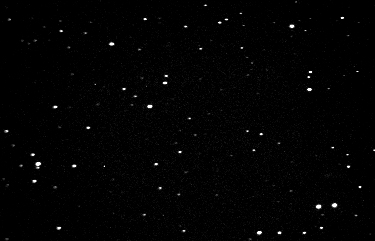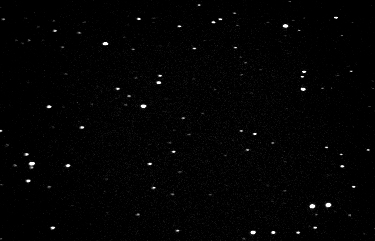
40 sec: Taken 3.11.2000 at Goodsell Observatory through an LX200 at f/6.3

40 sec: Taken 3.11.2000 at Goodsell Observatory through an LX200 at f/6.3
My final goal for the term was to get an image of the asteroid 2000 UG11. I recieved the orbital
elements for this near-earth-asteroid from a Sky and Telescope fast-mover e-mail (sent
from Roger Sinnott). 2000 UG11 was discovered on 25 October 2000 by Lincoln Laboratory's
1.0-meter LINEAR robotic telescope in New Mexico which is operated by M. Blythe, F. Shelly, and
colleagues. I recieved the e-mail on 28 October, but could not look for it for nearly a week
until the sky cleared (by this point, it had been cloudy/raining for nearly 2 straight weeks...
Boo-hoo :-(
So, the search was on. On 1 November, I took out a telescope and with a window of about 30
minutes before the clouds came back, attempted to point myself in the correct direction. I took
three decent pictures of what may or may not have been the correct area and then had to quit, as
rain was moving in (rain + electronic equipment = bad!). The next day, when I looked at the images,
I could tell I didn't find anything. In fact: I wasn't even in the correct area.
The trick to finding asteroids, or any object that moves against the background stars, is to take
repeated images of the object, with enough spacing between them that the object will have moved
between images. Then you compare the two (I used Photoshop and the Gimp in Linux to do this by
overlaying the images, with one of them semi-transparent) and look for things that are not the same
between two exposures.
Try that with these two images, if you are so inclined. These images were taken 3 November, the
next night I went to try to find 2000 UG11, are both of the same region of sky and have had their
contrast and brightness scaled identically. (Hint: there are two different spots between them...
bonus points if you can find them yourself).

40 sec: Taken 3.11.2000 at Goodsell Observatory through an LX200 at f/6.3

40 sec: Taken 3.11.2000 at Goodsell Observatory through an LX200 at f/6.3
If you didn't find them (or thought you might have), the two distinct differences are both on the
left side of the images, one a bit above center and one a bit below. I found those two the next
day, after I had taken a large number of images and was trying to see if I had found anything (I
didn't have time the night I took them, because I left the observing pad at about 2:30am, and I had
class the next day!). I was rather excited, as these were the only images that displayed distinct
differences. However, after showing them to Cindy, we decided that they were probably both gamma
ray hits. This idea came from their size -- 3 pixels each -- and relative brightness. The stars
that you see are brighter in the center and taper as you move out from the center and brighter
stars take up more space. These were very compact and did not show up in any other images of this
area, so they were probably just gamma rays from the atmosphere passing through the camera. So
what happened? I thought I was in the right area! Read on for more...